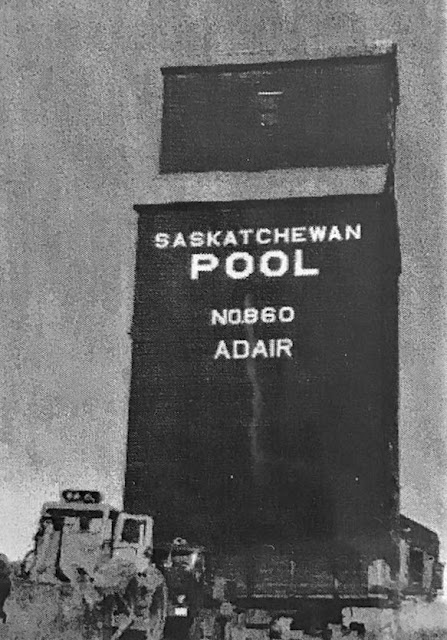The first stop on my grain elevator photography tour in 1985 was in Davin, SK. I had to wonder why the elevator was lettered Adair! That's because the Saskatchewan Wheat Pool (SWP) No. 860 elevator at Adair, built in 1928 was moved to Davin, on CN's Glenavon Subdivision, in 1964. The move would have been about 45 miles, almost due west. Adair was located six miles southeast of Wolseley, SK on the CP Reston Subdivision running from Wolseley (CP Moose Jaw Sub) to Reston, MB (CP Arcola Sub).
The CP Reston Subdivision secondary line left the CP mainline at Wolseley, and there were at least 15 stations on the line, seven to nine miles apart. The line's passenger train ('the Peanut') took 14 hours to go 122 miles! I can honestly say that I've never heard any of the towns' names on the line! Likely because after its 1908 construction and successive decades of operation, it was abandoned by 1961. (Here's a photo of another Reston Subdivision SWP elevator being moved - from Wawota to Dalzell. An interesting convoy with annex, drive-shed, and office tagging along!)
Marion MacRobbie kindly shared three black & white photos including two of the move, as well as one in colour. Though it looks perilous, elevators being moved can withstand a fair bit of torsion. Built of boards nailed flat and interior bins, they are extremely solid! And judging from the top photo, it's not like the move had to fight trafffic!
This move hints at the early consolidation of elevators into larger plants - a much cheaper option than new construction. The first consolidation by SWP was in 1962, and within five years, 18 elevators had been moved and consolidated with existing elevators. To show the changes that consolidations and closures had on the SWP, In 1971, there were 1,225 elevators in SWP's network - by 1982 that number had decreased to 625.
In some ways, I feel sorry for those ardent photographers who still venture out to photograph the remaining wooden elevators. Many are privately-owned, and not many are rail-served. In other ways, perhaps those who were photographing elevators in the 1940's to 1970's felt sorry for those of us taking photos in the mid-1980's!
With the line abandoned one to two decades before most of the branchline abandonments, some elevators survived in their native state up to the present: Deveron, Baring, Bender and Neelby are some of the line's elevators that are still sought out by wooden-elevator photographers. Marion MacRobbie's earlier photo of cousins posing at Adair in the 1940's.
A 1957 aerial photo of Davin shows a Canadian Northern Third Class station with two grain elevators - Saskatchewan Wheat Pool and National. The latter was absorbed into Cargill Grain. A 1984 CN listing showed Cargill's 1540-tonne and SWP's 1380-tonne elevators.A 1950's aerial photo of Adair shows a CP portable station and water tower.
My 1985 photos of the Davin elevator with its metal bins amid a very light snowfall!
Kerry Olson was managing the plant at Davin in 1984 when it closed. Davin was named for Nicholas Flood Davin (1840-1901), an Irish-Canadian Regina lawyer and publisher who had a locality, street and school named in his honour. It's nice to have this mystery solved 37 years after my visit to Adair, er, Davin.
Running extra...
Things got interesting when the auto-translate of Tim Hayman's excellent St Lawrence Division Zoom presentation on modelling VIA took over. In a few seconds, the all-important word 'consist' was variously translated as 'conscious' and 'Kansas'. Were not in consist anymore, Toto! Screen capture:
A very good video of the restoration of the CN Kingston Sub mainline, after the collision off the north main track between CN Nos 149 and 532 in Prescott in September, 2021. Just look past the graphic that shows CN 3108 as an RS-18!
Instead of a front-patio layout this year, I'm reactivating my outdoor modelmaking skills. Watch for updates and an upcoming post on the Blue & Red Cushions Construction Co.! Take it outside!
.jpg)






Moving the Adair elevator the 45 miles would have been a long, slow process. It looks like they are using a crawler tractor of some kind. So, they were probably moving at only 2 or maybe 3 miles per hour.
ReplyDeleteThe elevator is already being decommissioned in your 1985 pictures, Eric. I see that the piping from the elevator's gerber to the steel bins has been removed and the resulting opening in the elevator wall has been boarded up. Perhaps they were going to move the steel bins for use at another location.
Hi Brian,
ReplyDeleteYes, before the use of multi-axle big rigs seen in later moves. The driveway ramps also looked to be not in use at Davin. I breezed through these towns so quickly that I didn't leave myself much time for interpretation of what I was seeing/photographing!
Thanks for your comment,
Eric